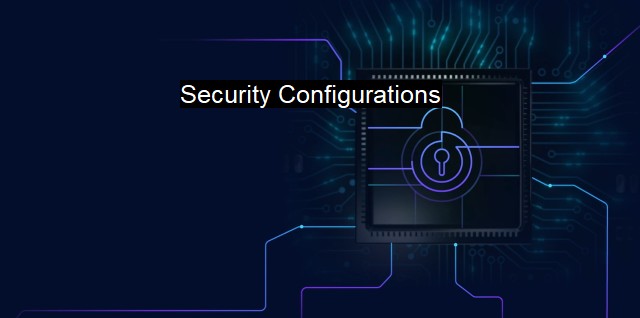What are Security Configurations?
Essential Understanding of Security Configurations: The Role in Achieving Robust Cybersecurity and the Personnel Involved
Security configurations are a vital aspect of cybersecurity practices that entail setting up secure infrastructure to guard against various threats and vulnerabilities. It involves foreseeable adjustments and modifications that augment a system's security aspects to ensure optimal protection. Solving cybersecurity issues necessitates involving security configuration, particularly for any software or hardware systems providing automation services in different fields.The matter of security configurations goes much deeper and is intricately tied up with every aspect of a system's setup. It incorporates assuring that policy settings, services, protocols, administrative controls, and access rights fully comply with the accepted best practices for security. The goal here is to establish an environment that is inherently resistant to security threats.
The exact settings for security configuration can vary tremendously based on the specific characteristics of a system - the technologies it employs, the nature of the data stored and processed, and indeed, what the system does. For instance, a database server storing sensitive patient information and a public web server of a newspaper will require substantially different security configurations.
It's paramount to appreciate that every technology opens up new vulnerabilities. Therefore, an equivalent security configuration needs to be applied. Suppose a system uses technologies with known vulnerabilities or susceptibilities to particular kinds of attacks. In that case, security configurations need to assure those vulnerabilities are securely patched and safeguards in place to mitigate threats from these attack vectors.
Various cybersecurity frameworks and guidelines lay out the best practices for security configurations. These configurations are frequently typified by rigid sets of rules that should be enforced on systems. There could be rules advising the use of unique strong passwords, enforcing regular software updates, disabling unnecessary services, and restriction protocols, among many others.
Sometimes, adjusting security configurations can benefit from security configuration management tools. These software solutions automate much of the configuration, guarantee the consistency of configurations, and facilitate regular audits, which ensure that systems remain secure over time. These tools can identify unwanted changes and inconsistencies, recommending remediation or allowing handy rollbacks.
It is crucial to use security configurations within the antivirus context. Antivirus software alleviates multiple threats like viruses, malware, spyware, phishing, and Trojans. Utilizing security configuration in antivirus software ensures that the scope of protection gets extended and the system integrity is preserved against unauthorized access.
With the rise of sophisticated attacks that bypass traditional antivirus mechanisms, configuring antivirus software settings becomes indispensable. you might need to adjust configurations on your antivirus software to cross-check with online databases for the newest malware kinds or set up a regular scan assurance against latent threats.
Where the antivirus program is deployed -whether on the end-point devices or network servers- may require different security configurations. For instance, antivirus software for email server protection might need to be configured to scrutinize all messages for malicious attachments, while end-point antivirus might be set to monitor behavior for signs of an infected system.
Security configurations must be regularly reviewed and updated. With new threats emerging and old vulnerabilities discovered, the landscape of cybersecurity is never static. Regular audits are crucial to ensure the system's defensive capability against evolving threats.
Security configurations represents a paramount aspect within the grand scheme of the cybersecurity landscape. It intertwines with the resolution of complex cybersecurity problems, aiding in creating outstanding security protocols that help counter evolving threats. Crafting tailored, robust security configurations, therefore, offers a significant boon in effectively deciphering and countering potential weak spots prone to cyber-attacks.

Security Configurations FAQs
What are security configurations?
Security configurations are the combination of settings and measures implemented to protect digital assets from security threats. These configurations can include antivirus software, firewalls, password policies, access controls, and other security measures.What is the role of antivirus in security configurations?
Antivirus software is a vital component of security configurations. Its primary function is to detect, prevent, and remove malicious software, such as viruses, worms, and trojans, from infecting computer systems. It continuously scans for suspicious activity and alerts users when potentially harmful software is identified.How can access controls improve cybersecurity in security configurations?
Access controls regulate who can access or modify sensitive information, resources, and systems. These controls limit unauthorized access and minimize the risk of cyberattacks. By implementing access controls, organizations can prevent data breaches and cyberattacks that occur due to a lack of proper authentication or authorization.What are some best practices for configuring security settings?
Some best practices for configuring security settings include regularly updating antivirus software and other security measures, using strong and unique passwords, implementing multi-factor authentication, backing up critical data, and restricting access to sensitive information. Additionally, it's essential to regularly train employees on cybersecurity best practices and to stay up-to-date on the latest threats and vulnerabilities.| | A | | | B | | | C | | | D | | | E | | | F | | | G | | | H | | | I | | | J | | | K | | | L | | | M | |
| | N | | | O | | | P | | | Q | | | R | | | S | | | T | | | U | | | V | | | W | | | X | | | Y | | | Z | |
| | 1 | | | 2 | | | 3 | | | 4 | | | 7 | | | 8 | | |||||||